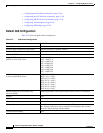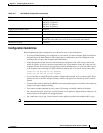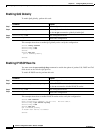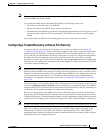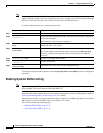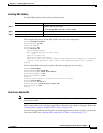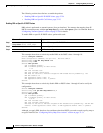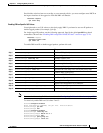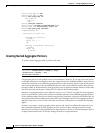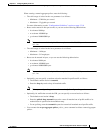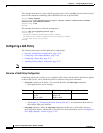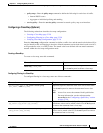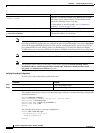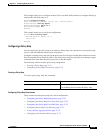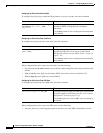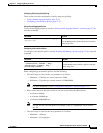
37-26
Software Configuration Guide—Release 15.0(2)SG
OL-23818-01
Chapter 37 Configuring Quality of Service
Configuring QoS on Supervisor Engines II-Plus, II+10GE, IV, V, V-10GE, 4924, 4948, and 4948-10GE
Switch(config-pmap-c)# dbl
Switch(config-pmap-c)# end
Switch# show policy-map cos
Policy Map cos
Class cos
dbl
Switch# configure terminal
Switch(config)# interface gigabitEthernet 1/20
Switch(config-if)# service-policy output cos
Switch# show policy-map interface
GigabitEthernet1/20
Service-policy output: cos
Class-map: cos (match-all)
0 packets
Match: cos 2 3
dbl
Class-map: class-default (match-any)
0 packets
Match: any
0 packets
Creating Named Aggregate Policers
To create a named aggregate policer, perform this task:
An aggregate policer can be applied to one or more interfaces. However, if you apply the same policer
to the input direction on one interface and to the output direction on a different interface, then you have
created the equivalent of two different aggregate policers in the switching engine. Each policer has the
same policing parameters, with one policing the ingress traffic on one interface and the other policing
the egress traffic on another interface. If an aggregate policer is applied to multiple interfaces in the same
direction, then only one instance of the policer is created in the switching engine.
Similarly, an aggregate policer can be applied to a port or to a VLAN. If you apply the same aggregate
policer to a port and to a VLAN, then you have created the equivalent of two different aggregate policers
in the switching engine. Each policer has the same policing parameters, with one policing the traffic on
the configured port and the other policing the traffic on the configured VLAN. If an aggregate policer is
applied to only ports or only VLANs, then only one instance of the policer is created in the switching
engine.
In effect, if you apply a single aggregate policer to ports and VLANs in different directions, then you
have created the equivalent of four aggregate policers: one for all ports sharing the policer in input
direction, one for all ports sharing the policer in output direction, one for all VLANs sharing the policer
in input direction and one for all VLANs sharing the policer in output direction.
Command Purpose
Switch(config)# qos aggregate-policer policer_name
rate burst [[conform-action {transmit | drop}]
[exceed-action {transmit | drop |
policed-dscp-transmit}]]
Creates a named aggregate policer.



